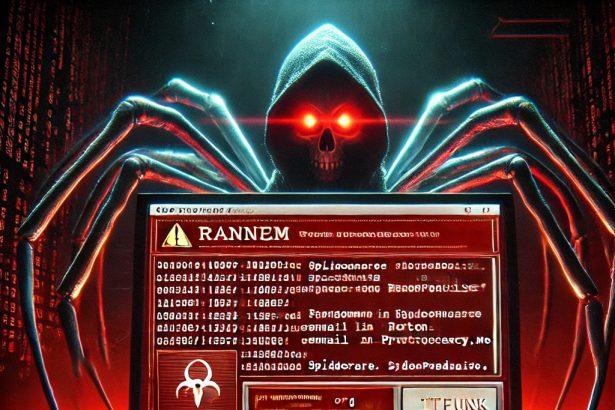Scattered Spider is not a standalone ransomware strain but a highly sophisticated cybercriminal grouping that orchestrates ransomware attacks—particularly on VMware ESXi environments—by exploiting human trust through advanced social engineering. Unlike most threats, this group bypasses technical vulnerabilities and instead infiltrates networks by impersonating employees to reset credentials and gain privileged access.
Threat Overview
While Scattered Spider is not a single ransomware, it frequently leverages ransomware-as-a-service (RaaS) variants such as BlackCat (ALPHV) and DragonForce to encrypt victim systems after gaining entry via social engineering. These attacks target high-value sectors including retail, airlines, insurance, and critical infrastructure through help‑desk impersonation and MFA bypass techniques.
Details Summary Table
| Field | Details |
|---|---|
| Threat type | Ransomware campaign leveraging third‑party ransomware (RaaS) |
| Detection names | UNC3944, Muddled Libra, Octo Tempest, Starfraud, Storm-0875, Roasted 0ktapus |
| Symptoms of infection | Unauthorized AD password/MFA resets, suspicious enrollment of new MFA devices, unexpected access to VMware vCenter or ESXi via SSH, deployment of encryption payload |
| Damage / Distribution | Data encryption and/or theft; rapid network lockdown across ESXi hosts; possible double extortion via stolen data |
| Danger level | High—targeting large enterprises with fast, multi‑layered attacks |
| Removal tool | SpyHunter: reliable malware detection and removal tool from Enigma Software |
Threat Facts & Evaluation
How I Got Infected
Victims are typically breached through voice-based social engineering and phishing/smishing. Attackers impersonate legitimate employees or executives and call IT help‑desk staff to request password resets or MFA device changes. They may also use phishing kits like Evilginx to capture credentials and session cookies in real time, bypassing traditional MFA.
What Does It Do
Once inside, attackers escalate privileges via stolen access to Microsoft Entra ID, SSO, VDI and then pivot to cloud or virtual infrastructure. Their goal is often to access VMware vCenter Server Appliance (vCSA), enable SSH on ESXi hosts, reset root passwords, and from there deploy ransomware across multiple virtual machines. They may also exfiltrate sensitive data for extortion demands.
Should You Be Worried
Absolutely. Scattered Spider is extremely dangerous—they are fast, deliberate, and scale attacks by targeting help‑desk workflows and managed service providers (MSPs), enabling them to impact multiple organizations simultaneously. Their youth, native English fluency, and team fluidity make detection difficult and law enforcement response challenging. This is not a run-of-the-mill malware vector but a fundamentally human‑driven infrastructure-level threat.
Detailed Attack Behavior
Scattered Spider campaigns unfold in carefully orchestrated phases:
- Initial compromise via help‑desk or phishing techniques (voice deception or Evilginx phishing).
- AD reconnaissance and privilege escalation, often using PowerShell tools like ADExplorer.
- Lateral movement into onboarding systems or SaaS environments.
- VMware compromise, gaining access to vCSA and enabling SSH access on ESXi hosts.
- Data exfiltration and ransomware deployment, frequently using BlackCat or DragonForce.
- Double extortion: encryption plus threat to leak data if ransom unpaid.
Their speed is notable—full breach to encryption can happen within a few hours.
Manual Ransomware Removal Guide
Warning: Manual removal is complex and risky. If not done correctly, it can lead to data loss or incomplete removal of ransomware. Only follow this method if you are an advanced user. If unsure, proceed with Method 2 (SpyHunter Removal Guide).
Step 1: Disconnect from the Internet
- Unplug your Ethernet cable or disconnect Wi-Fi immediately to prevent further communication with the ransomware’s command and control (C2) servers.
Step 2: Boot into Safe Mode
For Windows Users:
- For Windows 10, 11:
- Press Windows + R, type
msconfig, and hit Enter. - Go to the Boot tab.
- Check Safe boot and select Network.
- Click Apply and OK, then restart your PC.
- Press Windows + R, type
- For Windows 7, 8:
- Restart your PC and press F8 repeatedly before Windows loads.
- Select Safe Mode with Networking and press Enter.
For Mac Users:
- Restart your Mac and immediately press and hold the Shift key.
- Release the key once you see the Apple logo.
- Your Mac will start in Safe Mode.
Step 3: Locate and Terminate Malicious Processes
For Windows Users:
- Press Ctrl + Shift + Esc to open Task Manager.
- Look for suspicious processes (e.g., unknown names, high CPU usage, or random letters).
- Right-click on the process and select End Task.
For Mac Users:
- Open Activity Monitor (Finder > Applications > Utilities > Activity Monitor).
- Look for unusual processes.
- Select the process and click Force Quit.
Step 4: Delete Malicious Files
For Windows Users:
- Press Windows + R, type
%temp%, and hit Enter. - Delete all files in the Temp folder.
- Navigate to:
C:\Users\[Your Username]\AppData\RoamingC:\Users\[Your Username]\AppData\LocalC:\Windows\System32
- Look for suspicious files related to the ransomware (random file names, recently modified) and delete them.
For Mac Users:
- Open Finder and go to Go > Go to Folder.
- Type
~/Library/Application Supportand delete suspicious folders. - Navigate to
~/Library/LaunchAgentsand remove unknown.plistfiles.
Step 5: Remove Ransomware from Registry or System Settings
For Windows Users:
Warning: Incorrect changes in the Registry Editor can damage your system. Proceed with caution.
- Press Windows + R, type
regedit, and hit Enter. - Navigate to:
HKEY_CURRENT_USER\SoftwareHKEY_LOCAL_MACHINE\Software
- Look for unfamiliar folders with random characters or ransomware-related names.
- Right-click and select Delete.
For Mac Users:
- Go to System Preferences > Users & Groups.
- Click on Login Items and remove any suspicious startup items.
- Navigate to
~/Library/Preferencesand remove malicious.plistfiles.
Step 6: Restore System Using System Restore (Windows) or Time Machine (Mac)
For Windows Users:
- Press Windows + R, type
rstrui, and hit Enter. - Click Next, choose a restore point before the infection, and follow the prompts to restore your system.
For Mac Users:
- Restart your Mac and hold Command + R to enter macOS Utilities.
- Select Restore from Time Machine Backup.
- Choose a backup prior to the ransomware infection and restore your system.
Step 7: Use a Decryption Tool (If Available)
- Visit No More Ransom (www.nomoreransom.org) and check if a decryption tool is available for your ransomware variant.
Step 8: Recover Files Using Backup
- If you have backups on an external drive or cloud storage, restore your files.
Automatic Ransomware Removal Using SpyHunter
If manual removal seems too risky or complicated, using a reliable anti-malware tool like SpyHunter is the best alternative.
Step 1: Download SpyHunter
Download SpyHunter from the official link: Download SpyHunter
Or follow the official installation instructions here:
SpyHunter Download Instructions
Step 2: Install SpyHunter
- Open the downloaded file (
SpyHunter-Installer.exe). - Follow the on-screen prompts to install the program.
- Once installed, launch SpyHunter.
Step 3: Perform a Full System Scan
- Click on Start Scan Now.
- SpyHunter will scan for ransomware and other malware.
- Wait for the scan to complete.
Step 4: Remove Detected Threats
- After the scan, SpyHunter will list all detected threats.
- Click Fix Threats to remove the ransomware.
Step 5: Use SpyHunter’s Malware HelpDesk (If Needed)
If you are dealing with a stubborn ransomware variant, SpyHunter’s Malware HelpDesk provides custom fixes to remove advanced threats.
Step 6: Restore Your Files
If your files are encrypted:
- Try No More Ransom (www.nomoreransom.org) for decryption tools.
- Restore from cloud storage or external backups.
Preventing Future Ransomware Attacks
- Keep backups on an external hard drive or cloud storage.
- Use SpyHunter to detect threats before they infect your system.
- Enable Windows Defender or a trusted antivirus program.
- Avoid suspicious emails, attachments, and links.
- Update Windows, macOS & software regularly.
Conclusion
Scattered Spider represents a new breed of cyber threat: identity‑focused, agile, and socially engineered. Rather than attacking software vulnerabilities, they exploit trust—particularly within help‑desk operations—to gain deep and often quickly irreversible access to corporate infrastructure. Robust defense requires phishing‑resistant MFA, vendor security controls, and human‑layer sensitivity to social engineering. Detection tools alone aren’t enough when the attackers prey on organizational procedures.




